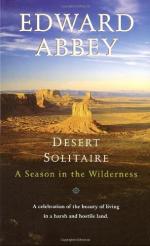|
This section contains 489 words (approx. 2 pages at 400 words per page) |

|
Desert Solitaire Summary & Study Guide Description
Desert Solitaire Summary & Study Guide includes comprehensive information and analysis to help you understand the book. This study guide contains the following sections:
This detailed literature summary also contains Topics for Discussion and a Free Quiz on Desert Solitaire by Edward Abbey.
Edward Abbey spends a six-month season in the Arches National Monument near Moab, Utah, working as a temporary park ranger. He is the only ranger at the park, which he prefers. Solitude agrees with Abbey, as does the oftentimes very silent desert.
An intense lover of nature, Abbey writes about the flora and fauna in a lyrical way. He knows all the names of the plants and animals, and much of the behavior of the native beasts. The behavior of visiting tourists does not appeal to him though, and he expresses strong contempt about their ways. Another thing that angers him is the ongoing development of the national parks. He thinks this destroys the wilderness, which should be preserved as everyone needs wilderness, whether they visit or not.
The main attractions at the park are the arches, no two alike. Abbey describes how nature creates them and the special features they have, including a delicate structure that, at a certain angle of view, resembles a wedding band. The park has three campgrounds that he maintains, along with his duties to help tourists in trouble and police the general area, consisting of 33,000 acres.
For diversion, Abbey helps a local rancher during the spring cattle roundup. He enjoys the work and does it for no pay. This leads to an attempt to capture one of the rancher's horses, a gelding that has gone wild, Old Moon-Eye. Try as Abbey might, Old Moon-Eye keeps his distance. The name of the horse refers to it having one bad, milky white eye.
Two desert adventures that Abbey chronicles involve a five-week stay near Havasu, a Native American settlement in a canyon off the Grand Canyon, and a rafting trip through Glen Canyon before the Glen Canyon Dam was completed, thus flooding the area to create Lake Powell. These two experiences do not seem to follow in time with the rest of the story, but they bring out important points. Abbey goes native while near Havasu and nearly dies in a canyon. The Glen Canyon trip brings out descriptions of the natural wonders that Lake Powell now covers.
Abbey helps to locate a sixty-year-old man in the desert who dies from exposure. Abbey also climbs the predominant peek of the area, Mount Tukuhnikivats. For his final adventure of the season, Abbey explores a small part of a remote network of canyons called The Maze. This involves an amount of technical mountaineering skills. Abbey does his first rappel.
The season ends, and Abbey must return to his home on the East Coast. He looks forward to rejoining civilization but has changed significantly over the past six months. His desire to come to know the desert in a deeply intimate way is not fulfilled, but he knows he loves the desert environment more than any other natural setting. He wants to return and wonders if he and the experience will be the same.
Read more from the Study Guide
|
This section contains 489 words (approx. 2 pages at 400 words per page) |

|



